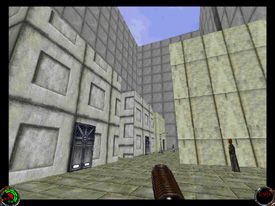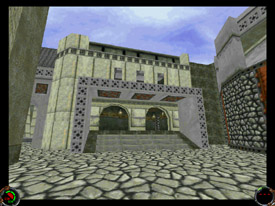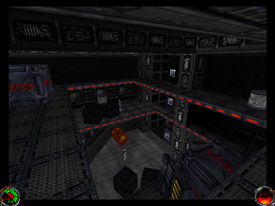Tutorial originally posted on commandchamber.net. Mirrored here for archival purposes
The Importance of Architecture
By Ryan
Why is architecture so important to a level? Well, the architecture IS the level (in the most basic sense). The space you create in which to stage your story and fight your battles is so much more than just an area for other things to take place inside. Instead, the level is part of the story itself, allowing level authors to carry us to the limits of imagination. With the engine provided by Jedi Knight and Mysteries of the Sith, the worlds you can create are virtually limitless. In actuality, the only limits are the time, effort and creativity the author puts into his or her project.
Joining the editing scene at the end of the Dark Forces era, I was amazed to see the capabilities of Jedi Knight when I first played through the LEC single player episode, "The Force Within". Unfortunately, many custom single player levels simply pale in comparison with this example. While some people may consider a level to be great just because it offers a good frag-fest, the truly exceptional level will make you feel as if you’re actually in the Star Wars universe. This means a realistic design and detail. Detail, detail, detail…you can’t create an atmosphere without it. Until a level looks real, you’re still sitting at your computer, playing a game. To succeed in creating a compelling environment, the level author has to go the extra mile. Don’t make a network of rectangular corridors connected to square rooms – this makes for repetitive and uninteresting gameplay. Instead, take those rectangular hallways and add details such as sloping support beams, overhead pipe junctions or small alcoves.

Poor architecture and texturing - Rectangluar, boxy design with textures that don't fit well with the architecture. Hardly any detail is present.

If you’re trying to represent a city, don’t be content with making a few large boxes to imitate buildings – create a real working city. Add rooftop areas, shops, cantinas, warehouses, back alleys, or anything else you can think of. Just as importantly, think three-dimensionally. Instead of expanding horizontally, take a trip down into an underground cavern or up to the rooftops. Force the player to have fun while they play by creating a level where you must jump across chasms, snake along narrow ledges, explore twisting tunnels or investigate multi-leveled buildings.
Always keep in mind the style of architecture that you are attempting to portray. An older city might incorporate stone arches, steps and utilitarian architecture, whereas a modern metropolis could contain high-rise buildings, spaceports, and a refined city look. An Imperial base would probably have a military type design, in addition to technological enhancements like elevators, metal support beams, and computer terminals. In addition to maintaining a particular style with a level’s architecture, keep in mind the general layout as well. Imperial bases are logically constructed and neatly arranged, while rural towns are usually more haphazardly built and less centralized.

Detailed architecture - 3D construction, great texture variation, realistic with a varied design accented by lighting and shadows.
Going hand in hand with architecture to create a style is texturing. Texture choice should always match what kind of environment you are creating. Small towns might display prominently stone, wood, concrete and other natural textures, while space stations and ships will utilize the more refined look of metal and mechanical texture choices. When designing a level, it is always important to maintain a good variety in texture choices, though it is not a contest to see who can use the most textures. Just as realistic, detailed architecture is necessary to give the level a memorable atmosphere, textures choices must also add to and enhance this atmosphere. This means choosing textures that mesh with the architecture and the overall design style of the level. If the author can utilize architecture and textures to create a detailed environment for the story to take place in, the level becomes more than just a game – it becomes reality.
If you have any comments or questions concerning this article, feel free to contact me by e-mail, or use the message board.



